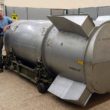In Syria, the United States has adopted a none-of-the-above strategy. President Barack Obama has launched airstrikes against ISIS targets in the Euphrates Valley and against an unrelated radical group near Aleppo. But the administration does not want airstrikes to benefit Syrian President Bashar al-Assad. So it proposes to spend $500 million to create a third force in Syria, an army of moderate freedom fighters who will take on both the Assad regime and the extremists.
The strategy does avoid choosing between Assad and the Islamic extremists, but it is hard to see how it would work. The Syrian Army numbers about 110,000 troops while ISIS may have as many 30,000 fighters in Syria and Iraq. The al-Nusra Front—the Al Qaeda-linked group now considered the moderates among the Islamists—has another 3,000 fighters. The U.S. is envisioning creating a force of 5,000. It is unclear as to exactly whom they would fight. Inevitably, the third force, if it could be created, would find itself aiding (even if there were no direct cooperation) one side or the other in the Syrian civil war.
The U.S. spent billions trying to create an army in Iraq and a police force in Afghanistan. The Iraqi Army—in spite of having state-of-the-art American weaponry and a 10-to-1 advantage in manpower—collapsed when ISIS attacked Mosul in June. The Afghan police are a predatory force that provides little security but fuels resentment that brings recruits to the Taliban. The Saudis will provide the initial training to the Syrians. Perhaps the Saudis will do a vastly better job than the Americans, but I know of no reason to think so.
We should get out of the business of regime change in Syria. We don’t know how to do it.
The administration says it will vet the third force to ensure there are no extremists included. The U.S. military and CIA engaged in extensive vetting in Afghanistan and could not stop the Taliban from infiltrating the police and the army, making so-called green-on-green attacks the second-leading cause of death for coalition troops after IEDs. In Syria, unlike in Afghanistan, the vetters have no access to the recruits’ hometowns.
The Less Bad Option
The Obama administration—and the hawks in Congress—see the choice between Assad and ISIS as a choice between two murderous tyrannies. Both sides have engaged in atrocities—the regime drops barrel bombs on civilians while ISIS crucifies and beheads captives—but there are also important differences between the two sides.
One third of Syria’s population are minorities: Alawites, Christians, Druze, Kurds, Shiites and Armenians, among others. None opposes the Assad regime. The armed opposition to Assad is entirely Sunni but not all Sunnis support the opposition.
The Alawites benefitted the most from the four-decade rule of their co-religionists, the Assads. Once at the bottom of Syria’s ethnic hierarchy, Alawites now dominate the top levels of the government and military. Some have become fabulously wealthy through their close association with the regime.
For many Alawites, the continuation of the Assad regime is not about privileges but survival. Religious Sunnis—and not just extremists—consider the Alawites apostates. Even in the early days of the uprising, when the extremists were a marginal factor, rebels chanted, “Alawites to the grave; Christians to Beirut.” Should Assad’s foes prevail, it is hard to see how Syria’s Alawites will escape genocide.
In Syria and Iraq, Christians generally tried to keep their heads down but this has not provided any protection to Iraq’s Christians (except in Kurdistan) and Syria’s Christians fear a similar fate. The Druze have had no role in Syria’s civil war but they, too, fear what might happen if the regime falls.
While the Assad regime has protected Syria’s religious minorities, it has discriminated against the country’s largest ethnic minority, the Kurds. Syria’s Kurds are Sunni but are secular in outlook. They have been fighting ISIS for 18 months, particularly around the city of Kobane on the Turkish border. They also have little use for the so-called moderate opposition, whom they see as Arab chauvinists unwilling to consider Kurds equal citizens of a new Syria.
The moderate opposition has made no real effort to reassure any of Syria’s minorities. Religious freedom, protection of Alawites, and Kurdish rights, have not been on the agenda. The Kurdish parties broke with the Syrian National Council—the opposition’s attempt to create an all-inclusive representative body—when it insisted Syria should continue to be the Syrian Arab Republic, a designation that excludes the non-Arab Kurds. Providing sufficient reassurance to religious minorities risks alienating the Islamists, and even the supposedly moderate opposition leaders prefer to keep the Islamists (though perhaps not ISIS) as an ally in the struggle against Assad.
In Syria, the choice is not among ISIS, the regime and a hypothetical third force. It is between a Sunni Arab movement dominated by extremists and the Syrian government. Neither side is democratic and both have lots of blood on their hands. Neither side tolerates dissent. But one side embraces and protects Syria’s religious diversity and its secular traditions. The other side seeks to exterminate that.
If Assad prevails, a pluralistic Syria continues and it may be reformed later. If the extremists prevail, a diverse Syria is gone and can never be recreated. Obama is right to strike at ISIS. It is an existential threat to Kurds, Shiites and religious minorities in both Syria and Iraq.
But he should get out of the business of regime change in Syria. We don’t know how to do it.
Our efforts will most likely prolong the war, get more people killed and have no positive result.
And if we somehow succeed, we may find what follows much worse.
Peter W. Galbraith, a former U.S. Ambassador to Croatia and Assistant Secretary General of the United Nations, is the author of The End of Iraq: How American Incompetence Created a War Without End, first published in 2006.







0 Comments